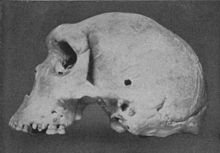Homo rhodesiensis
Homo rhodesiensis is a hominin species described from a single fossil skull. It was found in the colony of Northern Rhodesia, (now Zambia) at a mine called Broken Hill (now Kabwe) in 1921. The skull lacks the lower jaw, but otherwise is almost complete. In addition to the cranium, an upper jaw from another individual, a sacrum (bone of the pelvis), a tibia, and two femur fragments were also found.
| Homo rhodesiensis Temporal range: Pleistocene
| |
|---|---|

| |
| Skull found in 1921 | |
| Scientific classification | |
| Domain: | |
| Kingdom: | |
| Phylum: | |
| Class: | |
| Order: | |
| Family: | |
| Tribe: | |
| Genus: | |
| Species: | H. rhodesiensis
|
| Binomial name | |
| †Homo rhodesiensis Woodward, 1921
| |
Rhodesian Man is dated to be between 125,000 and 300,000 years old. Cranial capacity of the Broken Hill skull has been estimated at 1,100 cm³.[1] Bada & al (1974) published a direct date of 110 ka for this specimen.[2][3] The brain size is rather small for such a late date. The destruction of the paleoanthropological site has made layered dating impossible.
The skull is from an extremely robust (= strong) individual, and has the comparatively largest brow-ridges of any known hominid remains. It was described as having a broad face similar to Homo neanderthalensis (i.e. large nose and thick protruding brow ridges), and has been interpreted as an "African Neanderthal". There are several features intermediate between modern Homo sapiens and Neanderthals. Most current experts believe Rhodesian Man to be within the group of Homo heidelbergensis. Other names, such as Archaic Homo sapiens and Homo sapiens rhodesiensis, have also been suggested.
References
change- ↑ Rightmire, G. Philip. The evolution of Homo erectus: comparative anatomical studies of an extinct human species Cambridge University Press, 1993. ISBN 0-521-44998-7, ISBN 978-0-521-44998-4.
- ↑ Bada, Jeffrey L. et al Concordance of collagen-based radiocarbon and aspartic-acid racemization ages Archived 2015-03-20 at the Wayback Machine PNAS abstract URL.
- ↑ Bada, Jeffrey L. (1985). "Amino acid racemization dating of fossil bones". Annual Review of Earth and Planetary Sciences. 13: 241–268. doi:10.1146/annurev.ea.13.050185.001325. Archived from the original on 2021-02-12. Retrieved 2012-06-08.